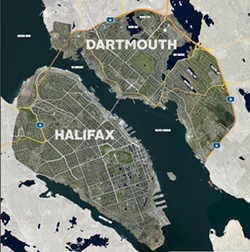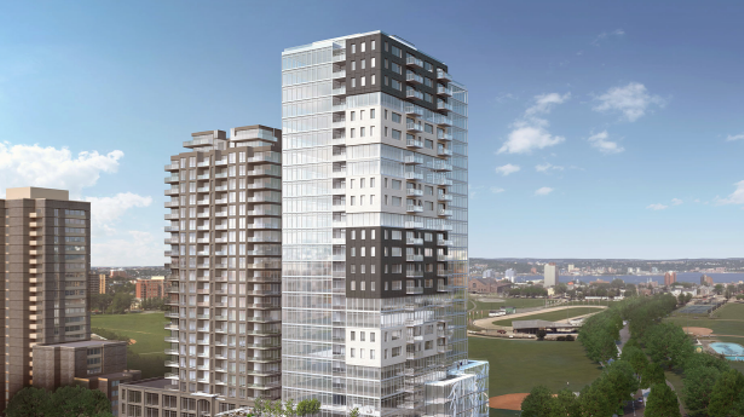An infinite future of changes to Halifax and Dartmouth’s streetscapes and planning zones got their first big seal of approval this week. After months—really years…decades even—of back and forth on big ideas and tiny details, Package A of the city’s Centre Plan was unanimously passed by regional council this week.
The plan aims to streamline and strengthen the rules and by-laws around the physical buildings that make up city life in HRM’s centre, as well as simplify some
of the processes around who gets a say in further development decisions, and gives the city a concrete start on the “what do we do about housing affordability” question. It covers the land of peninsular Halifax and across the bridges between the harbour and the Circ.
Councillor Sam Austin called it a “huge, huge step forward,” in agreeing on where growth should go, what form it will take, and eliminating one-off arguments over site-specific developments. He said if anything, it should give citizens and developers a more consistent expectation of what’s to come in your area.
At a public hearing on Tuesday, for over two hours local residents and developers spoke to councillors about the plan. Many were developers or developer-adjacent asking for site-specific changes to the plan. Some were previous planners who were just there to say, "great work, folks," and a few residents who were disappointed in the way the changes would affect their own or neighbouring streets.
After clarification and debate from councillors, a large number of the site-specific requests were shelved in amendments to be revisited in Package B—which also includes decisions around parks and open spaces among other things.
Then staff held their breath as councillors went back and forth on a few more contentious items.
The first of which was the plan’s plan for affordable housing or as mayor Mike described it, “the big nut.” The city has moved forward with a density bonusing program, which will let developers construct a building bigger than the now set rules around size as long as they pay a “density bonus” AKA cash money into a fund earmarked for affordable housing initiatives—permission to colour outside the lines in exchange for funds that will likely be directed to housing-related non-profits and organizations. Staff has six months to figure out what exactly that looks like.
Density bonusing won out over not inclusionary zoning—which would have put set rules around which kind and how many units (read: affordable units) must be included in a development in certain areas—after the province decided to give density bonusing the green light and red-light the latter.
At the public hearing, developer Peter Polley said opting for density bonusing over inclusive zoning was like encouraging non-profits to open grocery stores, instead of working with grocery stores to help with food affordability, calling the density bonusing too restrictive.
Developers asked staff to reconsider charging the density bonus—applied to any proposed development exceeding 2,000 square metres of floor area (an NHL sized hockey rink is about 1,500 square metres) at the early permit stage in the building process. Staff said they had looked into it but there was no spot in the process after the initial permit issuing where they could hold developers on the hook for the money.
Some councillors argued that charging this fee upfront would result in increased rents, minimizing affordability.
Staff have maintained throughout the process that a goal of the plan is to increase the housing supply. General economics tells us that increased supply—as long as it’s not accompanied by even higher increases in demand—should keep prices down. Vacancy rates hit their lowest point in 2018 at 1.6 percent and word on the street is they’re even lower right now. (In The Coast’s recent Renter’s Survey, 43 percent of the over 500 respondents said their rent is going up in the next year.)
Councillors Matt Whitman, David Hendsbee, Russel Walker, Stephen Adams and Tim Outhit voted against the chunk of the Centre Plan that was separated from the big vote, which called for a reorganization of the sub-committees that got to make decisions about which buildings went where and what they were like. Outhit said he hit the wrong button and meant to vote yes. Hendsbee, who asked for this bit to be separated from the main vote argued that this would strengthen the rural-urban divide on council.
The plan, with its goal of simplification, will mean no more as-you-go public hearings for big buildings as we know the process now. Their permission is baked into the new rules—or can be achieved by paying into the density bonusing purse—to dig down and build up. But Package B is still to come and up for debate, so Halifax as we know it could stick around for a couple of more years yet.
















